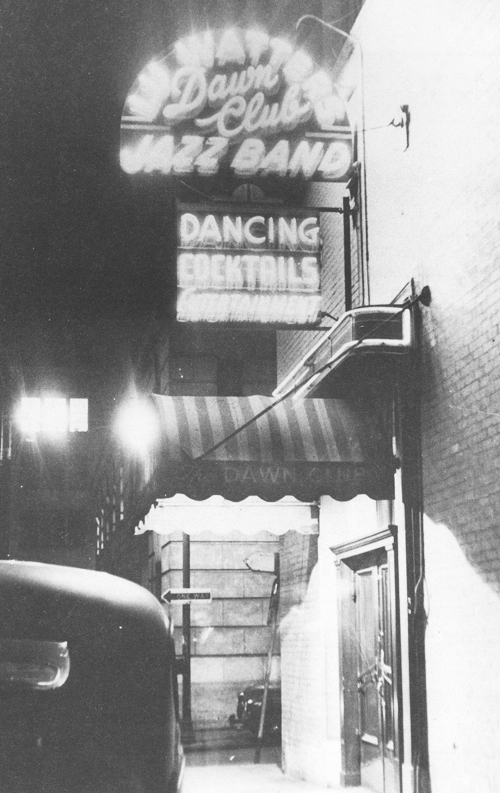
The exterior of The Dawn Club, photo courtesy of Donna Huggins.
In the winter of 1940, if you looked down the alley in back of the Palace Hotel in San Francisco, you would see a hot pink, neon sign shining through the fog. In big capital letters it advertised, DANCING, COCKTAILS, ENTERTAINMENT. #20 Annie Street was the address of a basement dive called The Dawn Club. The décor was funky, with lots of dark wood and dim light. The Dawn Club was a favorite nightspot for the college crowd and a growing number of traditional jazz fans who were tired of the overdone ‘Big Band’ sound.
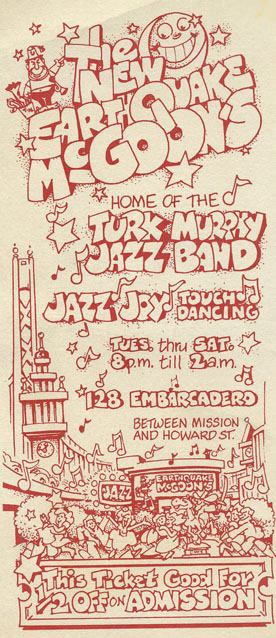
Earthquake McGoon’s Handbill, courtesy Donna Huggins.
True believers in West Coast Traditional Jazz preached their gospel at The Dawn Club, at Hambone Kelly’s across the Bay, and later at the Hangover Club and Earthquake McGoon’s. Beginning in 1939, bandleader and cornetist Lu Watters and trombonist Turk Murphy gave the movement its impetus, and it kept right on rolling across the country well into the 1970s. A second and third generation continues to this day, including many jazz artists who have appeared on the Riverwalk Jazz radio series.
Disciples of ‘The Real Stuff’ themselves, The Jim Cullum Jazz Band pays tribute to The West Coast Classic Jazz Revival with the help of Chicago tuba player Mike Walbridge and Bay Area cornetist and Turk Murphy veteran Leon Oakley.
Many of the revivalists were veteran jazzmen, bored with working in bloated Swing bands, playing commercial, showbiz music and precious little jazz. They were enchanted with the heartfelt authenticity and excitement of music from a bygone era. They brought a muscular, inventive approach to the roots of jazz and made it their own.
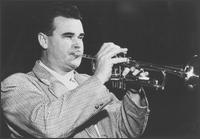
Cornetist Lu Watters, photo courtesy Donna Huggins.
Both Watters and Murphy were serious students of early jazz. Watters wrote many new arrangements of old tunes, breathing life into them. Almost all the tunes in their playbook, such as “Cakewalkin’ Babies From Home,” “My Heart," "Sunset Cafe Stomp" and others—hearkened back to New Orleans repertoire created by King Oliver, Louis Armstrong, Jelly Roll Morton, W.C. Handy and Clarence Williams. Watters and Murphy composed originals like “Emperor Norton’s Hunch” and “Big Bear Stomp” inspired by people and places in the Bay Area. All of these tunes, and more, are featured in our radio show.
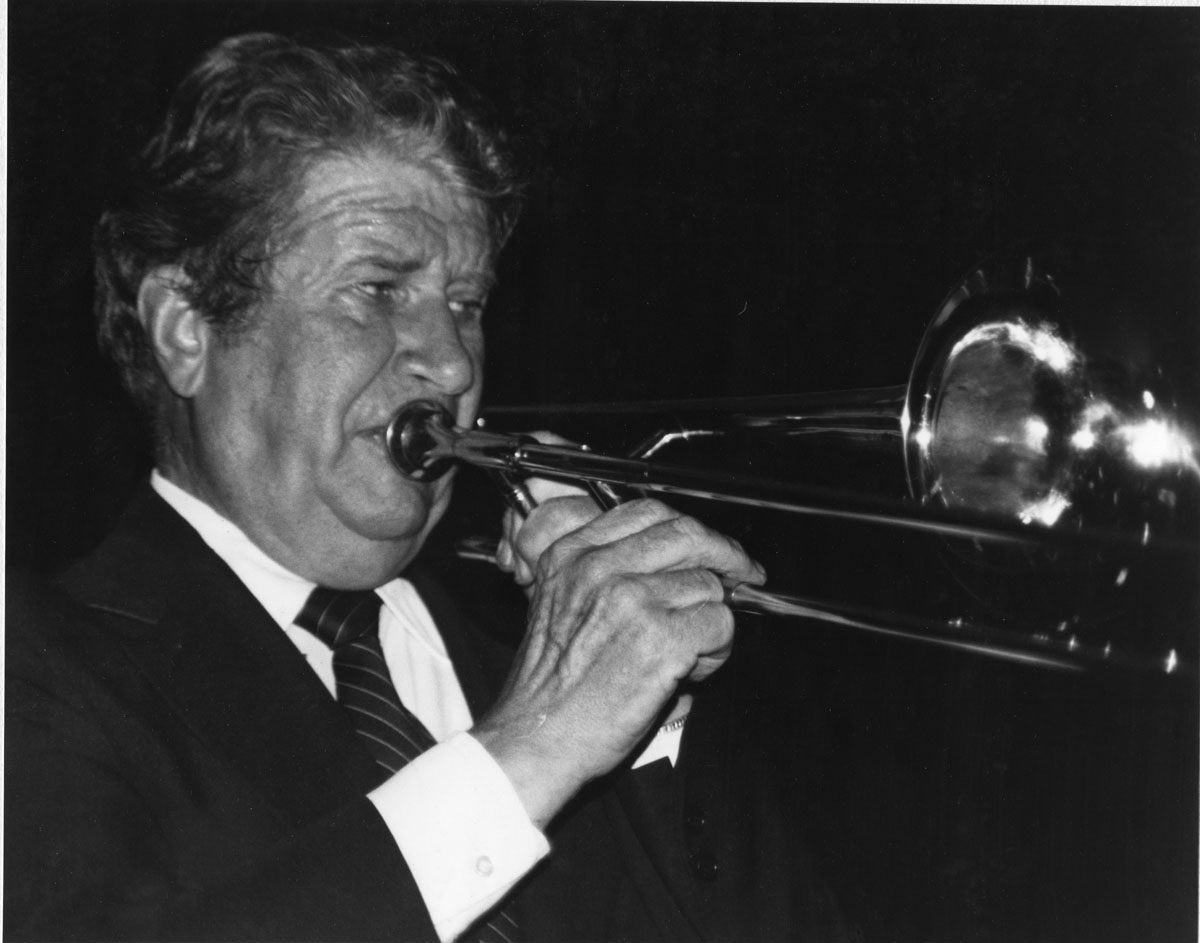
Trombonist Turk Murphy, photo courtesy Donna Huggins.
The instrumentation and performance practices of the Yerba Buena Jazz Band might well be considered antique—the use of banjo instead of guitar, tuba instead of string bass, ragtime piano, snare drum-oriented drumming instead of time played on ride or sock cymbals, and two-to-the-bar bass. The horns produced a rough-edged, blues-drenched sound inspired by Oliver, Armstrong, Johnny Dodds, Kid Ory and others.
At the heart of the West Coast style is the jazz ensemble chorus—all horns blowing improvised jazz at once in a spirited cacophony that is both chaotic and highly structured. Jim Cullum says, “Like the King Oliver band, the basis of the Yerba Buena Jazz Band was ensemble playing. Lu’s vision drove the band sound.” Jim’s extensive use of the jazz ensemble in his own band is a defining quality that sets it apart from others on today’s jazz scene.
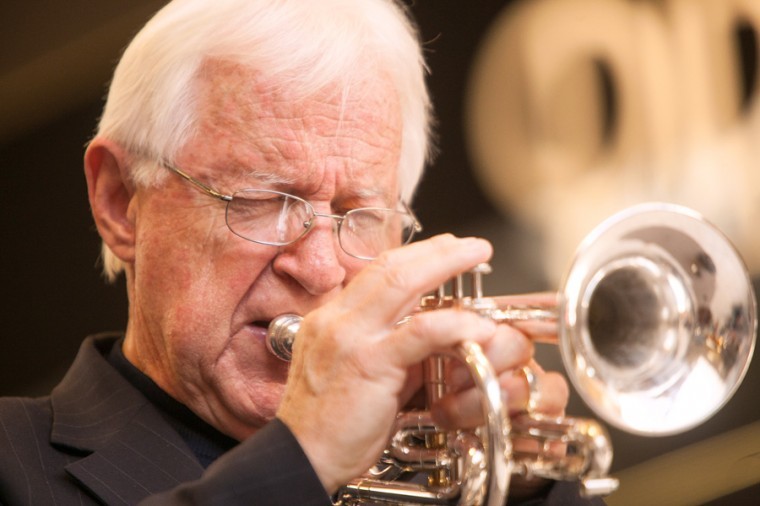
Cornetist Leon Oakley, photo courtesy Donna Huggins.
Lu Watters said the foundation of the traditional jazz he played was dancing. Like his model, King Oliver, who got the crowds up on their feet at Chicago’s Lincoln Gardens, Lu loved to play to a packed dance floor. Then, late at night, after last call, with the tables strewn with empty glasses and the lights low, the Watters band would wind down with a haunting, slow blues by W. C. Handy—”Friendless Blues,” a tune often played by The Jim Cullum Jazz Band.
Photo credit for Home Page teaser image: Ad for The Dawn Club, image courtesy of Donna Huggins.
Text based on Riverwalk Jazz script by Margaret Moos Pick ©2012

